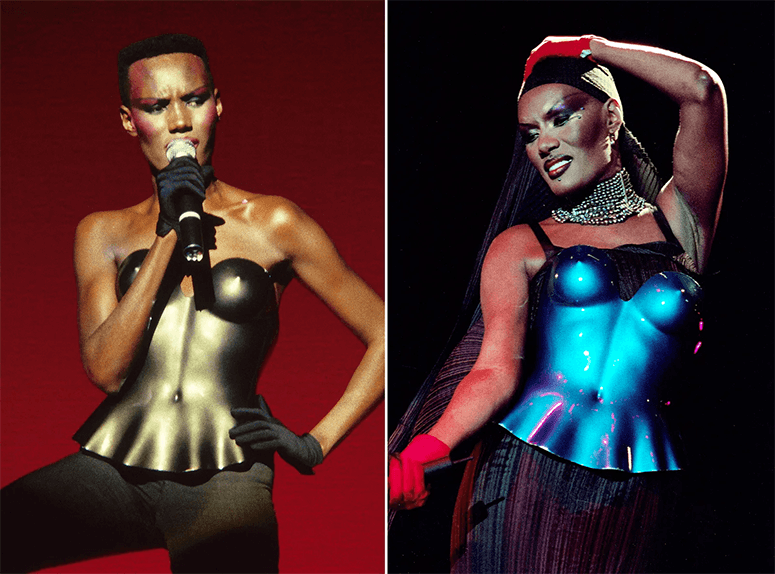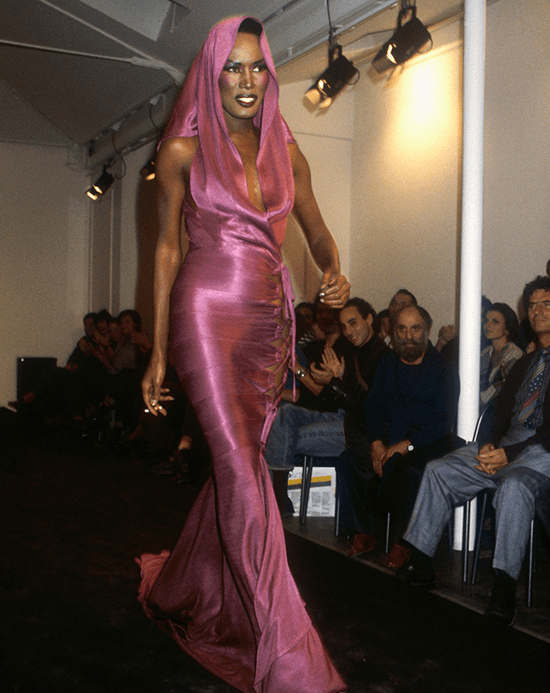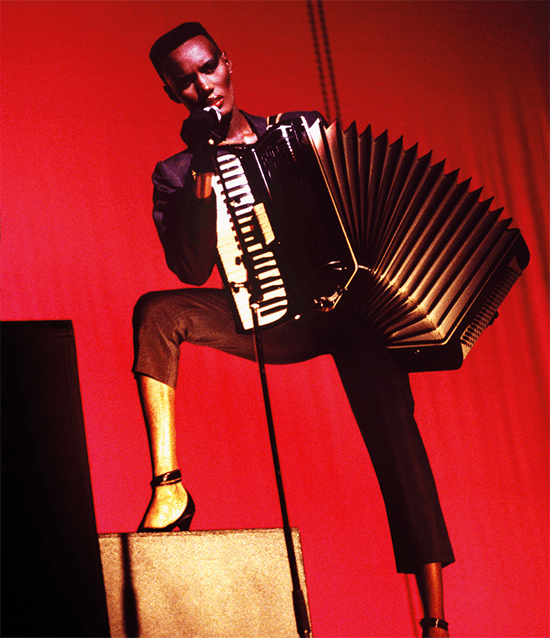Grace Jones is back in fashion
Actually, Grace Jones never really left fashion. “Icon” has been the abused cliché used to describe her because her looks have repeatedly been copied in the past decades, so much so that she has become a classic.
Embodying the decadent club style of the ’70s and ’80s, she was an unlikely contender for timelessness since her shocking, boundary-breaking aesthetics always had a hint of danger, “a mixture of beauty and threat,” which Jean-Paul Goude, one of her frequent collaborators, liked most about her.
At the recent spring-summer 2023 runways, Jones’ bigger-than-life shoulders were seen as leather jackets at Saint Laurent, as were her hooded jumpsuits, which also appeared at Versace, Ferragamo and Alaïa.
Just take her 1981 album cover, “Nightclubbing,” which is probably one of the most famous in the history of music. She wears Giorgio Armani, who was at the height of his popularity for deconstructing the suit, discarding the over-the-top padding to offer a relaxed option to formalwear in the film American Gigolo. Yet the piece by the designer that she chooses is a padded, wide-shouldered suit with an angularity that is further emphasized by being worn bare underneath to reveal her prominent chest bone and matched with a flat-top haircut. As a counterpoint, an unlit cigarette dangles nonchalantly from her lip to express a noir-bisexuality, which the writer Rick Poynor called “a duality with absolute composure and no false histrionics.” It was an arresting image of androgyny that retains its cool factor in today’s gender fluidity.

At the recent spring-summer 2023 runways, Jones’ bigger-than-life shoulders were seen as leather jackets at Saint Laurent, as were her hooded jumpsuits, which also appeared at Versace, Ferragamo and Alaïa. The hood, which became ubiquitous during the pandemic as a form of protection from a world that has become more oppressive, acquires an air of defiance when it is referenced from the looks of the singer. Her head covering may also have symbolized protection from the blatant racism that she faced when she arrived in 1970 in Paris where a leading agent told her that “selling a black model was like trying to sell an old car nobody wants to buy.” But she replied prophetically, “I’m going to make you eat your words.”

True enough, the fashion scene embraced her for her boldly androgynous and dark-skinned appearance—modeling for the runways of Yves Saint Laurent, Claude Montana, Kenzo Takada and Azzedine Alaïa and appearing on the covers of Vogue, Elle and Stern as photographed by Helmut Newton, Guy Bourdin and Hans Feurer. Sharing an apartment with Jerry Hall and Jessica Lange, she frequented Le Sept, the popular gay club, where she hobnobbed with Armani and Karl Lagerfeld.

Modeling, which she later described in her memoirs as “throwaway,” eventually made her restless, so she promptly parlayed her visibility into a music career that started with her club-ready cover of Edith Piaf’s La Vie En Rose, which became a big hit in Europe in 1977.
She later became a high-profile figure in the Studio 54-centered disco scene in New York. Her highly sexualized and flamboyant live shows earned her the title “Queen of the Gay Discos.”

This disco-diva phase would come to a close, however, as the genre’s popularity began to wane. Ever the chameleon, she transitioned to New Wave, radically reinventing her sound to reflect her aggressive personality and diverse musical influences, which included reggae, funk, post-punk and pop.
Using her distinctive image to enrich her equally distinctive music, Jones was always a true original that the new generation looks up to.
She also began to embrace her imposing voice, encouraged by Island Records founder Chris Blackwell, who she says “didn’t care that I sounded like a man or an entity.” Her peculiar vocal technique, somewhere between half-speaking and half-singing, would become a perfect complement to her visual style that celebrated blackness and subverted gender norms, something never seen before.

“She was lithe, sexy and hyperfeminine while also exuding a ribald, butch swagger,” says Dolly Bing Bing, a queer Belgian performance artist and pop musician who, 40 years later, says Jones still inspires her because my muscles make me look androgynous and yet I play with my sexuality.”
Using her distinctive image to enrich her equally distinctive music, Jones was always a true original that the new generation looks up to. The lyrics of Walking In the Rain sum up this image: “Feeling like a woman, looking like a man, sounding like a no-no, mating when I can.” A game-changer, “the tune was animalistic and sexual and self-aware,” says Honey Dijon, an internationally renowned DJ-producer. “It made me feel free to be myself in all its complex dimensions—she gave me joy and hope.”

By the ’80s, Jones further enhanced her multihyphenate pop culture status by transitioning into acting with roles opposite Arnold Schwarzenegger in the 1984 Conan the Destroyer and Roger Moore in the 1985 Bond film A View to a Kill, which coincided with the release of one of her biggest music hits, Slave to the Rhythm.
She had many comeback attempts to release an album in the ’90s, but this would only be realized in 2008 with Hurricane’s autobiographical songs.

She would influence many artists through the years—from Annie Lennox to Lady Gaga and Rihanna to Lorde—and would join concerts like an inspirational gala in Sao Paolo in 2012 to raise funds for AIDS research. Her irreverent style would continue to make news—keeping a hula hoop spinning on her waist while performing at the diamond jubilee of Elizabeth II and presenting Tom Jones with not only the GQ Men of the Year Award, but her underwear as well for good measure—revisiting how fans would do the same during his heyday.
This year, she served as curator of the 27th edition of the Meltdown Festival, the UK’s longest-running, artist-curated music festival, where she announced that she was doing a brand-new African hybrid record. She was also tapped by Beyoncé to do a feature in her “disco-trap” record “Renaissance,” even donning Mugler-inflected pieces as a tribute to Jones.
At 74, Grace Jones maintains her relevance, remaining a potent force and influence. “She takes you to higher vibrations through her presence alone,” says Dijon. “She frees you completely because she is free herself.”


